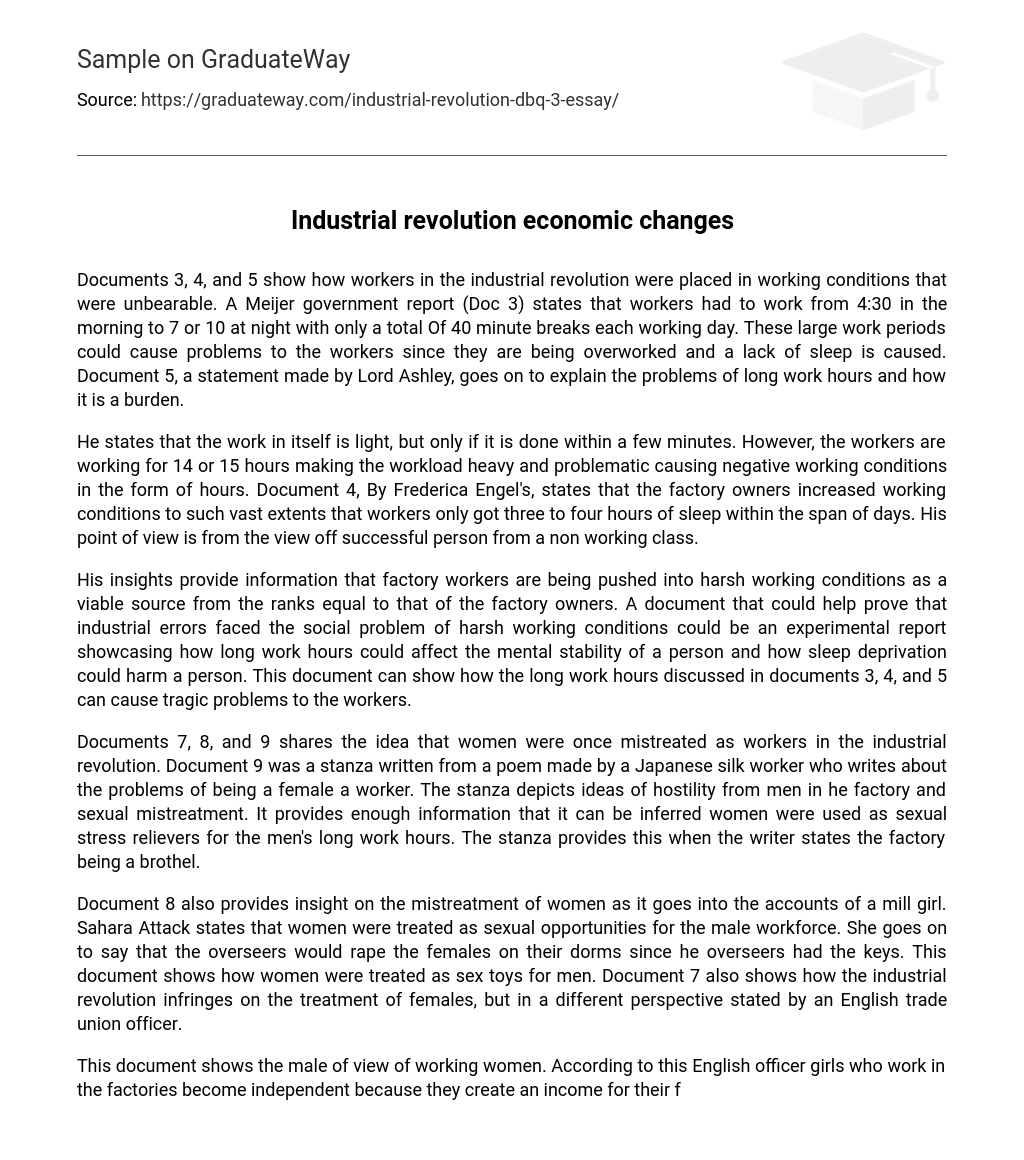Documents 3, 4, and 5 show how workers in the industrial revolution were placed in working conditions that were unbearable. A Meijer government report (Doc 3) states that workers had to work from 4:30 in the morning to 7 or 10 at night with only a total Of 40 minute breaks each working day. These large work periods could cause problems to the workers since they are being overworked and a lack of sleep is caused. Document 5, a statement made by Lord Ashley, goes on to explain the problems of long work hours and how it is a burden.
He states that the work in itself is light, but only if it is done within a few minutes. However, the workers are working for 14 or 15 hours making the workload heavy and problematic causing negative working conditions in the form of hours. Document 4, By Frederica Engel’s, states that the factory owners increased working conditions to such vast extents that workers only got three to four hours of sleep within the span of days. His point of view is from the view off successful person from a non working class.
His insights provide information that factory workers are being pushed into harsh working conditions as a viable source from the ranks equal to that of the factory owners. A document that could help prove that industrial errors faced the social problem of harsh working conditions could be an experimental report showcasing how long work hours could affect the mental stability of a person and how sleep deprivation could harm a person. This document can show how the long work hours discussed in documents 3, 4, and 5 can cause tragic problems to the workers.
Documents 7, 8, and 9 shares the idea that women were once mistreated as workers in the industrial revolution. Document 9 was a stanza written from a poem made by a Japanese silk worker who writes about the problems of being a female a worker. The stanza depicts ideas of hostility from men in he factory and sexual mistreatment. It provides enough information that it can be inferred women were used as sexual stress relievers for the men’s long work hours. The stanza provides this when the writer states the factory being a brothel.
Document 8 also provides insight on the mistreatment of women as it goes into the accounts of a mill girl. Sahara Attack states that women were treated as sexual opportunities for the male workforce. She goes on to say that the overseers would rape the females on their dorms since he overseers had the keys. This document shows how women were treated as sex toys for men. Document 7 also shows how the industrial revolution infringes on the treatment of females, but in a different perspective stated by an English trade union officer.
This document shows the male of view of working women. According to this English officer girls who work in the factories become independent because they create an income for their family. However, this sis problem to the men because of the patriarchal views drawn up by society. In their eyes the man should be the independent and the women are the dependent. This document shows the idea of disrespect of women independence and the stunting of it. Although this document does not show physical mistreatment, it provides mistreatment in the form of ideas and thoughts.
A document that can be added to complete this group can be statistical evidence showing that women are prone to being pregnant if they work in a factory due to mistreatment buy men. This would merge with the other documents because it shows proof that women were actually mistreated in the industrial revolution as workers. Although women were mistreated, they Were the dominant workforce in the industrial revolution. Documents 1, 2, 6, and 10 provide evidence for this notion. Document 1 show statistics from the Oxford press how the numbers of female workers are largely greater than that of the male workers in English textile factories.
Document 2 shows similar results of how women were the larger workforce in silk factories located within Japan. Document 6 states that women employment in Japan is temporary meaning that the females can be replaced at any time with new girl workers still containing female majority in work. In the West females stay in work after marriage but due to the harsh long work they cannot maintain it and are then replaced. Document 10 was written by Harriet Robinson in 1834. It shows dominance of women by their ability establish a revolt against their oppression.





